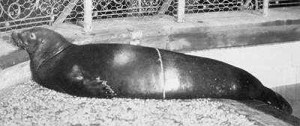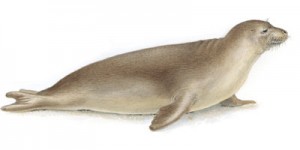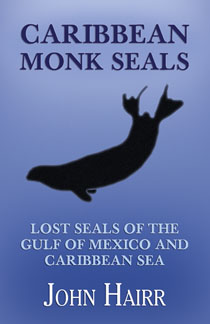Two New Caribbean Monk Seal Books
Posted by: Loren Coleman on December 15th, 2010

This is an image of a captive Caribbean monk seal of an unknown gender at the New York Aquarium in 1909. This specimen was originally captured from either Arrecifés Triángulos (Campeche) or Arrecife Alacrán (Yucatan) in Mexico (Townsend 1909). New York Zoological Society, 1910.
Today, quite coincidentally, I learned that two new books on the Caribbean Monk Seal or West Indian Monk Seal (Monachus tropicalis) have been published.

First, there is Remembering a Species: A History of the Caribbean Monk Seal in Captivity by Charles Epting, from Lulu Press (ISBN: 978-0-557-92778-4).
Here is what is said about this volume:
“This book chronicles the fascinating, untold story of the Caribbean Monk Seal: the only seal native to the Caribbean Sea, the only species of true seal that has gone extinct in recent times, and, perhaps most interestingly, the only species of recently extinct mammalian carnivore that was displayed in captivity. This book looks at both scientific sources and primary sources to gather what is known about this species’ life in captivity in one volume.”
Epting writes me to say his book “details the Caribbean Monk Seal when it was kept in captivity in multiple aquariums on the East Coast between 1897 and 1913. I know that this species is a cryptid, and there are occasional reports of its continued existence.”
It was released in December 2010, (at $7.95 USD, 73 pages).

Meanwhile, Chad Arment has published the other book on the Caribbean Monk Seal.

Caribbean Monk Seals: Lost Seals of the Gulf of Mexico and Caribbean Sea by John Hairr, is a new selection from Coachwhip Publications. The book has a release date of January 3, 2011, but is available as of today, (at $14.95 USD,
190 pages).
Arment summarizes the contents: “Hairr explores the history of this now extinct (most likely) monk seal, its intersection with various cultures, and expeditions in search of any possible remaining survivors.”
These cryptozoology library worthy volumes appear to be two good companion texts covering different aspects of what is known about this special species.

About Loren Coleman
Loren Coleman is one of the world’s leading cryptozoologists, some say “the” leading living cryptozoologist. Certainly, he is acknowledged as the current living American researcher and writer who has most popularized cryptozoology in the late 20th and early 21st centuries.
Starting his fieldwork and investigations in 1960, after traveling and trekking extensively in pursuit of cryptozoological mysteries, Coleman began writing to share his experiences in 1969. An honorary member of Ivan T. Sanderson’s Society for the Investigation of the Unexplained in the 1970s, Coleman has been bestowed with similar honorary memberships of the North Idaho College Cryptozoology Club in 1983, and in subsequent years, that of the British Columbia Scientific Cryptozoology Club, CryptoSafari International, and other international organizations. He was also a Life Member and Benefactor of the International Society of Cryptozoology (now-defunct).
Loren Coleman’s daily blog, as a member of the Cryptomundo Team, served as an ongoing avenue of communication for the ever-growing body of cryptozoo news from 2005 through 2013. He returned as an infrequent contributor beginning Halloween week of 2015.
Coleman is the founder in 2003, and current director of the International Cryptozoology Museum in Portland, Maine.










“…the only species of recently extinct mammalian carnivore that was displayed in captivity.”
Other than the Tasmanian Tiger? This seems like a pretty big miss for what is otherwise presumably a well-researched book. Not a reason to pass it over, but a surprising over-reaching statement nonetheless.
Yes, I was going to say the same thing concerning the thylacine.
Hi everyone,
Thank you very much for your comments. As for the question about the Thylacine–When I said the only extinct mammalian carnivore that was displayed in captivity, I was referring to the only member of taxonomic group Carnivora, and not meat-eating mammals in general (as the Thylacine was a carnivorous marsupial). I’m sorry if there was any confusion, this will be more clear in future editions of the book.
Thanks again!
-Charles Epting
I predict that it will be proved some time that our beloved Thylacine is in fact NOT extinct.